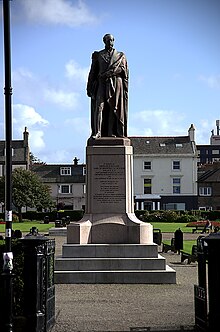|
Archibald Montgomerie, 13th Earl of Eglinton
Archibald William Montgomerie, 13th Earl of Eglinton, 1st Earl of Winton, KT, PC (29 September 1812 – 4 October 1861), styled Lord Montgomerie from 1814 to 1819, was a British Conservative politician. He was Lord Lieutenant of Ireland in 1852 and again from 1858 to 1859. Early lifeEglinton was born in Palermo, Sicily, the son of Major-General Archibald Montgomerie, Lord Montgomerie (30 July 1773 – 4 January 1814), the eldest son of Hugh Montgomerie, 12th Earl of Eglinton. His mother was Lady Mary Montgomerie (died 1848), daughter of General Archibald Montgomerie, 11th Earl of Eglinton. After his father's death, his mother married Sir Charles Lamb, 2nd Baronet. He was educated at Eton.[1] As a pastime he enjoyed playing golf. One of his playing partners was James Ogilvie Fairlie.[2] CareerEglinton was a staunch Tory. In 1846, he was a whip in the House of Lords; on 28 May 1846, he spoke against the Corn Importation Bill; in May 1848 he opposed the Jewish Disabilities Bill. [1] In February 1852, he became Lord Lieutenant of Ireland under the Earl of Derby. He retired with the ministry in the following December. When Derby returned to office in February 1858 he was again appointed Lord-Lieutenant, and he discharged the duties of this post until June 1859.[1][3] In this year he was created Earl of Wintoun, an earldom which had been held by his kinsfolk, the Setons, from 1600 until 1716, when George Seton, 5th Earl of Wintoun, was deprived of his honours for high treason.[3] Anstruther gives the date for this creation as 1840.[4] The Earl's kinswoman, Georgina Talbot, in celebration of the restoration of the title, gave the slightly altered name 'Winton' then in Hampshire now Winton, Dorset to a residential development in Bournemouth, which she was creating at this time.[5] Horse racingLord Eglinton's main object of interest for some years was the turf; he kept a large racing stud and won success and reputation in the sporting world.[3] His most successful horse was The Flying Dutchman which won The Derby and St Leger Stakes in 1849.[6] The Eglinton TournamentIn 1839, Lord Eglinton's name became more widely known in connection with the Eglinton Tournament. This took place at Eglinton castle and is said to have cost him £30,000 or £40,000. Contemporary ridicule is better remembered today than its successes. It was partly spoiled by the unfavourable weather, the rain falling in torrents, but it was a real tournament, participants having attended regular training during the course of the year prior and lances being broken in the orthodox way. Prince Louis Napoleon (Napoleon III) and Lady Seymour, a granddaughter of Richard Brinsley Sheridan and the wife of Lord Seymour, afterwards 12th Duke of Somerset, took part. A list of the challengers with an account of the jousts and the mêlée will be found in the volume on the tournament written by the Reverend John Richardson, with drawings by James Henry Nixon (1843). It was also described in Disraeli's Endymion.[3] Personal life Lord Eglinton married, firstly, on 17 February 1841, Theresa Howe Cockerell, née Newcomen, widow of Captain Richard Howe Cockerell RN (1798–1839, buried Park St, Calcutta). Mrs Cockerell was an illegitimate daughter (out of 8 children)[7] of Thomas Gleadowe-Newcomen, 2nd Viscount Newcomen (1776–1825) and his long-term mistress Harriet Holland. Theresa Newcomen was born in Calcutta in 1809, and died on 16 December 1853 at Eglinton Castle. They had the following children:
According to Eglinton's entry in the Oxford Dictionary of National Biography, as cited here, this marriage was the great mistake of his life. However, his stepdaughter Anna Theresa Cockerell (1836–1912), aided by her mother's second marriage, went on to marry Charles Chetwynd-Talbot, 19th Earl of Shrewsbury. After Theresa's death in December 1853, her widower married, secondly, the Hon. Adela Caroline Harriett, daughter of Arthur Capell, 6th Earl of Essex, in 1858. They had the following children:
Lady Adela died in December 1860, aged only 32. Lord Eglinton survived her by less than a year before dying at Mount Melville House, near St. Andrews, on 4 October 1861, and was buried in the family vault at Kilwinning, Ayrshire, on 11 October 1861. He was succeeded by his eldest son Archibald.[1] LegacyA statue of Lord Eglinton was erected in St Stephen's Green, Dublin in 1866 and was destroyed in an explosion by the IRA in 1958.[8] In New Zealand, Mount Eglinton and the Eglinton River are named in his honor.[9] See alsoNotes
Attribution:
References
External linksWikisource has the text of the 1885–1900 Dictionary of National Biography's article about Montgomerie, Archibald William.
|
||||||||||||||||||||||||||||||||||||||||||||||
